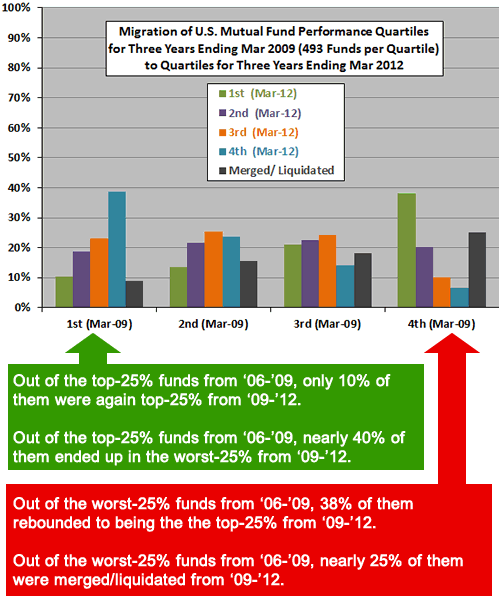
It is very tempting to invest in an actively-managed mutual fund that has above-average returns. Why would you invest in the ones with below-average returns? However, there’s something behind the whole “past performance does not guarantee future results” fine print. While there will always be funds that outperform, it is exceedingly difficult to pick them out in advance.
Index provider Standard & Poor’s publishes something called the S&P Persistence Scorecard twice a year, which examines the persistence of mutual fund performance over consecutive and overlapping time periods. By using quartiles, relative performance is compared, not absolute performance. Do the funds that had top returns in the past continue to have top returns? The newly-released study confirms the general conclusions of many other similar studies on persistence of actively-managed mutual fund performance:
- Lack of staying power (persistence). The top-performing funds over a certain period of time are less likely to stay on top than what would be expected even randomly. In fact, often they are more likely to be at the bottom than anything else.
- Reversion to the mean. Often, previously top-performing funds do even worse going forward than the previously bottom-performing funds. Sometimes the bottom-performing funds end up popping back up to the top when given the chance. Going back farther than 2006, the only place we see any persistence at all is in the very poorly-performing funds.
- The weak ones get killed off and swept under the carpet. The poorly-performing funds are much more likely to be quietly liquidated or merged into another fund. This contributes to survivorship bias, where it seems like more funds out there beat the market than really do.
The Scorecard has lots of good stats, even though the charts can be a little hard to follow. CXO Advisory Group put together the top graphic above based on the Three-Year Transition Matrix (Exhibit 3), which compares fund performance from 2006-2009 to what happened later in 2009-2012. I added the red and green boxes with my own clarifying comments.
In my opinion, generating excess return (beating the market) the long-run is possible, but it is much, much harder than most people think. Individual investors should experiment with active mutual funds or individual stock-picking with a portion of their portfolio at first and be very honest when comparing results to a passive strategy. The majority of investment professionals themselves cannot beat the market consistently after costs.
 The Best Credit Card Bonus Offers – March 2024
The Best Credit Card Bonus Offers – March 2024 Big List of Free Stocks from Brokerage Apps
Big List of Free Stocks from Brokerage Apps Best Interest Rates on Cash - March 2024
Best Interest Rates on Cash - March 2024 Free Credit Scores x 3 + Free Credit Monitoring
Free Credit Scores x 3 + Free Credit Monitoring Best No Fee 0% APR Balance Transfer Offers
Best No Fee 0% APR Balance Transfer Offers Little-Known Cellular Data Plans That Can Save Big Money
Little-Known Cellular Data Plans That Can Save Big Money How To Haggle Your Cable or Direct TV Bill
How To Haggle Your Cable or Direct TV Bill Big List of Free Consumer Data Reports (Credit, Rent, Work)
Big List of Free Consumer Data Reports (Credit, Rent, Work)
Not to nitpick, but shouldn’t this say “don’t pick mutual funds based on past performance over a short period of time”? I understand it is quite difficult to find a fund that outperforms its peers or the market year after year, but if they are out there, would you not consider that a worthwhile criteria for choosing to invest?
There are funds that have outperformed their peers “year after year”, in the past. However, that is also not a predictor of future performance.
Always something to consider. Thanks for the reminder.
To Deymond…
Google “Bill Miller beats S&P.” A fund that outperforms year after year doesn’t guarantee anything.
Past performance is the least worthwhile criteria IMO. Fee and investment objectives are more important.
Based on this graph maybe the best strategy would be to buy the funds that have performed the worst over the past 3 years (or 5, or 10 or whatever period). I think it would be a fun experiment if someone could calculate how that would have worked out over several different time periods in the recent past.
look for funds with 5 and 10 year outperformance, not annual. a fund that outperforms over the long haul tends to continue to outperform…here’s why: each fund company has their 4 or 5 star flagship funds who get the best managers, the best ideas, top analysts, etc. the fund family needs these to continue top performance as it is their only real form of advertising for new $. the flagship fund will pull money into other non-performing funds as advisors an clients stick with one fund family for break points, convenience, etc…